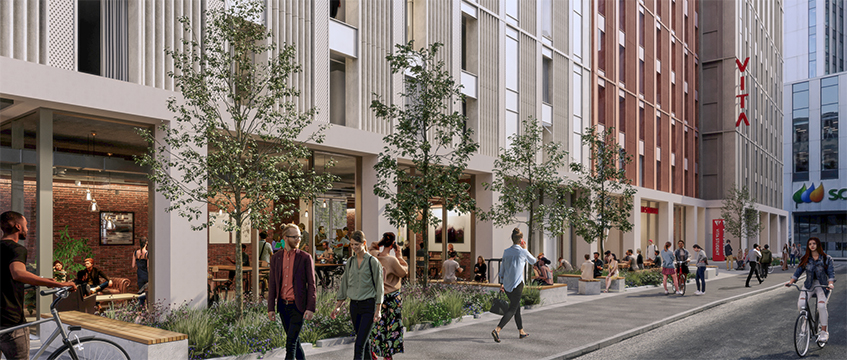Arrowdell Ltd v Coniston Court (North) Hove Ltd
Mr George Bartlett QC, president
[2013] EWHC/EWCA Civ xxxx (xx)
Collective enfranchisement – Leasehold Reform, Housing and Urban Development Act 1993 – Purchase price – Relativity – Leasehold valuation tribunal determining price payable on enfranchisement of block of flats – Powers of Lands Tribunal on appeal from that decision – Whether LVT erring in relying on applying relativity figure derived by reference to own knowledge and experience in preference to evidence of parties – Whether properly valuing prospect of developing roof of property – Appeal allowed
The leasehold valuation tribunal (LVT) was asked to determine the price payable by the respondent nominee purchaser to the appellant freeholder to acquire the freehold interest in a block of flats in Hove on a collective enfranchisement under the Leasehold Reform, Housing and Urban Development Act 1993. The LVT determined the price at £265,000. In doing so, it adopted a relativity percentage of 91.25% of freehold value when valuing the existing leases of flats with 63 years to run, considering that such a figure was supported by its own knowledge and experience of relativities agreed between parties in other similar cases. It also included the sum of £35,000 as value attributable to the prospect of developing the roof space of the building to create further flats, notwithstanding that, at the valuation date, planning permission for such development had been refused.
Collective enfranchisement – Leasehold Reform, Housing and Urban Development Act 1993 – Purchase price – Relativity – Leasehold valuation tribunal determining price payable on enfranchisement of block of flats – Powers of Lands Tribunal on appeal from that decision – Whether LVT erring in relying on applying relativity figure derived by reference to own knowledge and experience in preference to evidence of parties – Whether properly valuing prospect of developing roof of property – Appeal allowed The leasehold valuation tribunal (LVT) was asked to determine the price payable by the respondent nominee purchaser to the appellant freeholder to acquire the freehold interest in a block of flats in Hove on a collective enfranchisement under the Leasehold Reform, Housing and Urban Development Act 1993. The LVT determined the price at £265,000. In doing so, it adopted a relativity percentage of 91.25% of freehold value when valuing the existing leases of flats with 63 years to run, considering that such a figure was supported by its own knowledge and experience of relativities agreed between parties in other similar cases. It also included the sum of £35,000 as value attributable to the prospect of developing the roof space of the building to create further flats, notwithstanding that, at the valuation date, planning permission for such development had been refused. On appeal from the LVT’s decision, the appellant contended for a higher purchase price of nearly £467,500. It submitted that the LVT had wrongly relied on its own knowledge to reach the figure for relativity and failed to give adequate reasons for that figure. It submitted that the proper relativity was 85%. It also argued that the LV had undervalued the prospect of developing the roof, that planning permission for such development was likely to be granted on appeal, and that the proper value was £150,000. The respondent did not itself bring any appeal but none the less argued that a lower valuation of £189,779 should be adopted, with a relativity of 92.5% and a nil valuation for the prospect of roof development. On the appeal, issues arose as to: (i) whether the Lands Tribunal could, on an appeal from the LVT and in the absence of a valid cross-appeal by the respondent, determine a price more favourable to the respondent than that which the LVT had determined; (ii) the use of the LVT’s own expertise as an expert tribunal; and (iii) the admissibility or weight to be attached to previous LVT decisions. Held: The appeal was allowed.(1) By section 175(4) of the Commonhold and Leasehold Reform Act 2002, the Lands Tribunal on appeal could exercise any power that was available to the LVT. That provision did not limit the power of the tribunal to giving effect to the contentions of the appellant so far as it found them to be made out. The relevant power of the LVT in the instant case was that contained in section 24 of the 1993 Act, empowering the LVT to determine the terms of acquisition that remained in dispute. In the instant case, the price payable for the freehold was in dispute. There was an appeal from the LVT’s determination on that issue and the Lands Tribunal accordingly had power to determine that matter. In doing so, it could determine a price higher or lower than that which the LVT had determined. That power served to mitigate the potential injustice that could otherwise result from the absence from the Leasehold Valuation Tribunals (Procedure) (England) Regulations 2003 and the Lands Tribunal Rules 1996 of any provision for cross-appeal. The tribunal could therefore entertain the respondent’s contentions that a price more favourable to the respondent should be determined, although that remained a matter for the tribunal’s discretion and it would only exercise the power to made a determination in such terms if satisfied that it was fair to do so. If it were satisfied on the evidence that the respondent’s contentions were correct, there would be no unfairness in giving effect to them. (2) It was appropriate for an LVT, as an expert tribunal, to use its knowledge and experience to test, and if necessary, reject, evidence that was before it. However, that was subject to three inescapable requirements. First, as a tribunal deciding issues between the parties the LVT had to reach its decision on the basis of evidence that was before it. Second, it should not reach a conclusion on the basis of evidence that had not been exposed to the parties for comment. Third, it had to give reasons for its decision. In the instant case, the LV had been entitled to reject the parties’ evidence on relativity provided that it gave its reasons for doing so. However, it had erred in basing its decision on its own knowledge and experience of relativities agreed between parties to other similar cases without identifying those agreements or giving the parties an opportunity to comment on them. That decision breached the second requirement and also the third requirement as to reasons. To support a valid decision, the reasons had to enable the parties to understand why the LVT had reached the conclusion that it had, rather than some other conclusion, so as to show that the conclusion was one to which the LVT was entitled to come on the evidence before it. (3) Although evidence of other LVT decisions on relativity was not inadmissible, the mere percentage figure adopted in a particular case would be of no evidential value. Each decision of an LVT was dependent on the evidence before it; thus, in order to determine how much weight should be attached to the figure adopted in a decision, it would be necessary to investigate what evidence the LVT had had before it and how it had treated that evidence. Such a process of investigation was potentially lengthy and it was inherently undesirable that LVT hearings should turn into rehearings of earlier determinations. Accordingly, while it was understandable that valuers negotiating the settlement of an enfranchisement claim might have regard to LVT decisions on relativity, as the best guide to the likely outcome if they were unable to reach agreement, those decisions did not constitute useful evidence in any subsequent proceedings. (4) If no assistance was derived from earlier LVT decisions, the same would go for settlements that had themselves been based on such decisions. In such circumstances, it was necessary for the tribunal, when determining relativity, to do the best it could with any evidence of transactions that could usefully be applied, even though such transactions took place in the real world rather than the no-Act world. Regard could also be had to graphs of relativity; such graphs were capable of providing the most useful guidance. Although relativities mighty vary between one type of property and another and from area to area, the predominant factor was the length of the lease term. It should be possible to produce standard graphs, distinguishing between mortgage-dependent markets and those that were no so dependent, on the basis of a survey of assessments made by experienced valuers addressing themselves properly to the hypothetical no-Act world. It was to be hoped that the RICS would carry out such an exercise and produce guidance in the form of standard graphs, which could readily be applied by valuers in carrying out enfranchisement valuations and could be used as evidence by LVTs, with the relativities that they showed being applied in the absence of evidence compelling the adoption of other figures. (5) In the instant case, the transaction evidence suggested that a relativity of 90% was too high but relevant graphs did not support the appellant’s figure of 85%. In the circumstances, it was appropriate to adopt a relativity of 88%. In light of the evidence that planning permission for the development of the roof was likely to be granted on appeal, it was appropriate to value the property on the assumption that such development was feasible. From a starting figure of £300,000, representing the unrestricted value with planning permission, a 50% deduction would be made to reflect the risks flowing from the current lack of planning permission. A hypothetical purchase would also make a further deduction of £10,000 to reflect the need to secure agreement to a restrictive covenant prohibiting that development. Applying those figures, the price payable for the freehold was £398,561. Philip Rainey (instructed by Pemberton Greenish) appeared for the appellant; Stan Gallagher (instructed by Farrington Webb, of Brighton) appeared for the respondent. Sally Dobson, barrister










